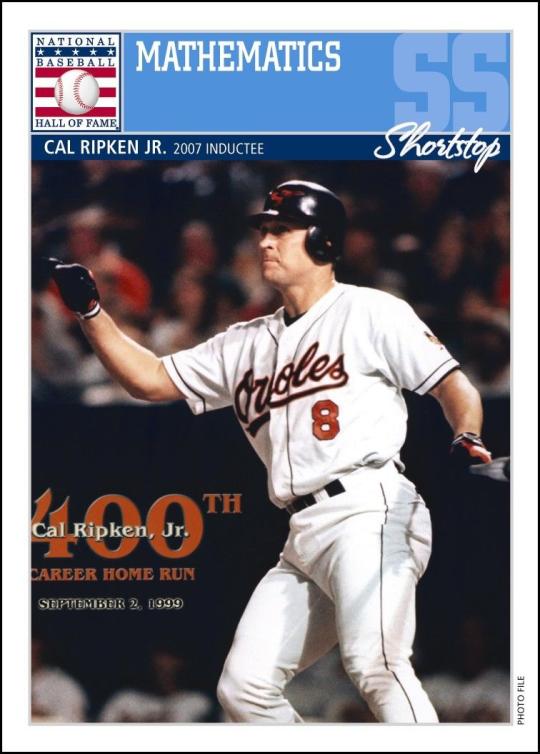Post-Visit: Fantasy Baseball
Lesson & Activity
*Note* The goal of this activity is for students to apply the material they have learned in this unit as well as in class. Ideally, students will be able to track their fantasy baseball teams for several weeks of a semester. Since most of the professional baseball season takes place in the summer, students may be limited to April-June and August-September depending on your school calendar.
1. Introduce this activity by explaining how fantasy baseball will work in your classroom. Students will act as managers of pretend baseball teams. They will choose teams composed of real players, and they will earn points based on their players’ performances in real games.
2. Each week, students will use newspapers or online resources to locate their players’ statistics and calculate the number of points earned by their teams. Points will be awarded as follows:
OFFENSE
- Single (1 pt), Double (2 pts), Triple (3 pts), Home Run (4 pts)
- Walk (1 pt), Hit By Pitch (1pt), Run (1 pt), RBI (1pt)
- Stolen Base (2 pts)
- Caught stealing (-1 pt), Strikeout (-0.5 pt)
PITCHING
- Win (7 pts), Save (7 pts)
- Each inning pitched (3 pts)
- Strikeout (0.5 pt)
- Walk (-1 pt), Earned Run (-1 pt), Hit Allowed (-1 pt), Hit Batter (-1 pt)
- Loss (-5 pts)
3. Set up a player draft. Students may either draft any current player in Major League Baseball for their teams, or they can be limited to a smaller pool of players of your choice (perhaps 50-75).
Statistics: Batter Up! - Level 3
4. No matter the complexity of the draft, make sure that students have time to examine their player options before a draft takes place. Discuss the values associated with different statistics as students are evaluating their potential draft picks.
5. During the player draft, students will need to choose players for the following positions:
- Hitters: C, 1B, 2B, 3B, SS, OF, OF, OF
- Pitchers: Starting (5), Relief (2)
- Bench: Five spots
6. For the sake of simplicity, students should keep the players they draft at the start of the season rather than attempting to negotiate trades.
7. You may choose to have students only keep track of their points throughout the season, or, you can set up weekly head-to-head competitions. In this case, pairs of student teams would compete against each other for one week at a time. The winner of each pair is the team with the most points at the end of the week. Teams are awarded wins and losses accordingly, and you can set up a chart showing classroom standings. With this method you can also set up class playoffs toward the end of the semester with the best teams going head-to-head until an overall winner is determined.
8. The league winner is the student whose team has the most points at the end of the season. Consider offering a small trophy or some other small prize for the winner.
Conclusion:
At the conclusion of the fantasy league, students may graph and compare a wide variety of different statistics. For example, students may compare class data for RBIs per player, fewest strikeouts per player, stolen bases per player, home runs per player, etc. Students may also assess the players on their own teams. For example, students could calculate the median number of RBIs for the season, the mean batting average and slugging percentage, or the standard deviation of stolen bases.
Common Core Standards
CCSS.Math.Content.HSN-Q.A.1 Use units as a way to understand problems and to guide the solution of multi-step problems; choose and interpret units consistently in formulas; choose and interpret the scale and the origin in graphs and data displays.
CCSS.Math.Content.HSN-Q.A.2 Define appropriate quantities for the purpose of descriptive modeling.
CCSS.Math.Content.HSA-REI.A.1 Explain each step in solving a simple equation as following from the equality of numbers asserted at the previous step, starting from the assumption that the original equation has a solution. Construct a viable argument to justify a solution method.
CCSS.Math.Content.HSA-REI.B.3 Solve linear equations and inequalities in one variable, including equations with coefficients represented by letters.
CCSS.Math.Content.HSS-ID.A.1 Represent data with plots on the real number line (dot plots, histograms, and box plots).
CCSS.Math.Content.HSS-ID.A.2 Use statistics appropriate to the shape of the data distribution to compare center (median, mean) and spread (interquartile range, standard deviation) of two or more different data sets.
CCSS.Math.Content.HSS-ID.A.3 Interpret differences in shape, center, and spread in the context of the data sets, accounting for possible effects of extreme data points (outliers).

